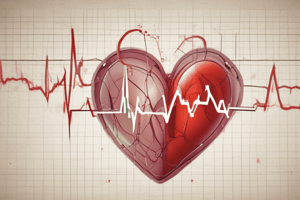Podcast
Questions and Answers
Match the following ECG electrode with its correct placement:
Match the following ECG electrode with its correct placement:
V1 = Over 4th intercostal space near right sternal margin V2 = Over 4th intercostal space near left sternal margin V3 = In between V2 and V4 V4 = Over left 5th intercostal space on the mid clavicular line
Match the following ECG electrode with its correct placement:
Match the following ECG electrode with its correct placement:
V5 = Over left 5th intercostal space on the anterior axillary line V6 = Over left 5th intercostal space on the mid axillary line RA = Right arm LA = Left arm
Match the following ECG electrode with its correct placement:
Match the following ECG electrode with its correct placement:
LL = Left leg RL = Right leg Lead wires = Connect electrodes to electrocardiograph Chest leads = Electrodes placed on chest for graphical representation
Match the ECG procedure with the corresponding step:
Match the ECG procedure with the corresponding step:
Match the ECG rhythm with its description:
Match the ECG rhythm with its description:
Match the following ECG components with their functions:
Match the following ECG components with their functions:
Match the following purposes of Electrocardiography (ECG) with their descriptions:
Match the following purposes of Electrocardiography (ECG) with their descriptions:
Match the following ECG applications with their purposes:
Match the following ECG applications with their purposes:
Match the following statements about ECG with their accuracy:
Match the following statements about ECG with their accuracy:
Match the following ECG purposes with their descriptions:
Match the following ECG purposes with their descriptions:
Match the following ECG applications with their uses:
Match the following ECG applications with their uses:
Flashcards are hidden until you start studying





